Hello and welcome!
As many of you know, last Sunday I was featured in a segment on the CBS television program 60 Minutes. This week, I wrote a column reflecting on that interview which appeared in our archdiocesan newspaper The Pilot and I want to share it with you here, as well:
Reflections on my ‘60 Minutes’ interview
Last Sunday evening I was privileged to be featured on the CBS television program “60 Minutes,” which is actually three 20 minute segments. I was featured in segment two of the broadcast. The whole experience was fascinating. I was very impressed by the entire team, their work ethic, professionalism and dedication. Those 20 minutes are distilled out of many hours of hard work. Correspondent Norah O’Donnell and producers Frank Devine and Magalie Laguerre —Wilkinson are all Catholics. Their faith and their regard for the Church was evident. Frank is a very well-informed Catholic who can engage in theological debate about “internal form” or any aspect of the life of the Church.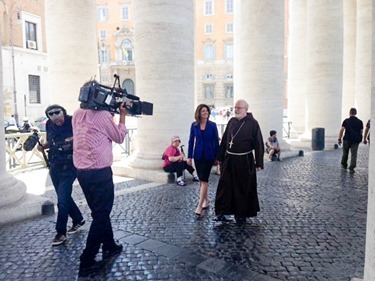
From the beginning of the process I was aware that the questions would not be about the weather and the Red Sox. The program’s interviews include difficult questions that are often on many people’s minds. For some people, being featured on 60 Minutes would be exhilarating, but television interviews are not at the top of my list of favorite things to do. Newscasts these days can be about sound bites and quick messaging. In contrast, 60 Minutes does a good job of trying to go deeper into the topics they address. My interview touched on three provocative issues that are seldom addressed by members of the hierarchy, but which once raised capture everyone’s attention. These matters call for more time and consideration than can be given in a 20 minute broadcast segment.
Not surprisingly, Norah asked a question about Bishop Robert Finn of the Diocese of St. Joseph-Kansas City and accountability. While it is the case that the sexual abuse policies adopted by the U.S. Conference of Catholic Bishops would preclude someone convicted of not reporting a crime from teaching religious education or having any position supervising children, some of the advance reporting about this matter did not reflect the nuances of my answer to the question. In response to Norah, I said that the Vatican must attend to this situation. The Holy Father is aware of this need, and recently an Episcopal Visitator was sent to Bishop Finn’s diocese. The Holy See had the sensitivity to send a Canadian bishop to conduct the visitation.
One of the significant concerns of the members of the Pontifical Commission for the Protection of Children, on which I serve as President, is the accountability of bishops. We are all aware that Catholics want their leaders to be held accountable for the safety of children, but the accountability has been sporadic. We need clear protocols that will replace the improvisation and inertia that has often been the response in these matters. Bishops also deserve due process that allows them to have an opportunity for a fair hearing. The situation in the Diocese of St. Joseph-Kansas City is a painful one; we pray that the visitation will help. After all that American Catholics have been through in the past decade, survivors and the community at large understandably are demanding transparency and accountability. As a Church, the safety of children must be our priority. At the same time, we need to provide justice for all and avoid crowd-based condemnations.
Another topic that has garnered much attention is the recent visitation of Leadership Conference of Women Religious (LCWR) and the communities of religious women. These were two different activities, conducted by distinct Roman congregations. I trust that there were serious concerns that gave rise to the visitations, but it would seem that better planning and a wider participation of American religious and U.S. bishops would have been helpful. The Church personnel who carried out these assignments have done an admirable job under very difficult circumstances. Unfortunately, many religious women have been alienated by the process and the bishops in this country have been blamed for shortfalls in communications and the process. Hopefully when the final report of the visitations is presented, it will be a more positive experience that will contribute to healing in our Church and be helpful for the cause of religious life. The upcoming Year of Consecrated Life called for by Pope Francis will be an opportunity to celebrate the great achievements of our religious and introduce a new generation of Catholics to consecrated life and its many opportunities to accomplish good works in the name of the Church.
A topic also of significant concern in the Church that was addressed during the interview is the discussion concerning the ordination of women to the priesthood. This is particularly painful to many Catholic women who feel that the teaching on women’s ordination is a rejection and unfair.
Throughout history, many wonderful Catholic women have wished to be priests, among them St. Therese, the Little Flower. In my comments I was trying to communicate that women are often holier, smarter and more hard-working than men, and that the most important member of the Church is a woman, the Blessed Virgin Mary. The Church is called to be faithful to Christ’s will, and that is not always easy or popular. Understanding the Church’s teaching is always a process that begins with faith.
As a person who is just an occasional viewer of television, I am amazed to learn of the number of people who watch 60 Minutes each week; this is certainly a credit to the quality of the program. I hope that one take-away from my 60 Minutes interview will be that cardinals, bishops and priests are human, and that we love the Church.
– – –
Now, on the the events of my week…
Friday, I celebrated the funeral Mass for Father Bob Doyle who had been retired for many years, but is still fondly remembered by many of his former parishioners. 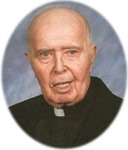
He had also served as the principal of Cathedral High School, among the other posts that he held during his long and fruitful ministry as a priest of the archdiocese.
– – –
Later that day I was visited at the Cathedral by Father Tim Butler and his brother. Father Tim is home from the Air Force and he stopped in to say hello.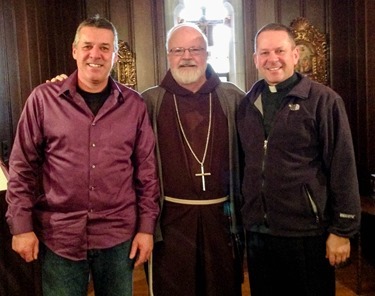
We are very grateful to the priests of the archdiocese who so generously serve our men and women of the Armed Forces as chaplains, and particularly those who have been deployed to war zones. Boston has a wonderful tradition of military chaplains. We are very proud of that tradition and very grateful for the service that they give. I am always very pleased when I have the opportunity to meet with our chaplains personally during their visits home.
– – –
Each year during November we celebrate a Memorial Mass for the deacons and deacons’ wives who have passed away, particularly those who have died in the last year. This year, our Mass for Deceased Deacons and Wives of the Archdiocese of Boston was held last Saturday.
The candles in front of the altar represent those who have died in the last year.
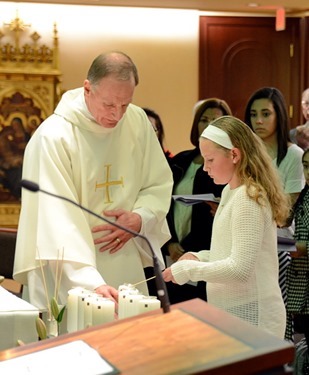 It is always a wonderful event, bringing together many of the deacons, deacons’ wives, their children and grandchildren.
It is always a wonderful event, bringing together many of the deacons, deacons’ wives, their children and grandchildren. 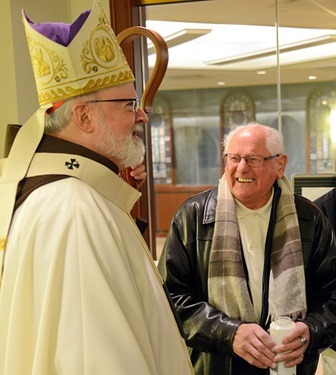
We are so grateful to Deacons Pat Guerrini and Dan Burns of our Permanent Diaconate Office for organizing the Mass and for all they do for the archdiocese.
– – –
On Sunday I celebrated the Mass for the feast of the Vietnamese martyrs at the Cathedral. The archdiocese is blessed with a great Vietnamese Catholic community. This year we gathered in the Cathedral to remember the Vietnamese Martyrs which, as I said in my homily, could be as many as 300,000 people — named and unnamed — over different periods of their history.
The Mass is always an extraordinary event with so many families and young children. We were also very pleased to have several of our Vietnamese seminarians serve the Mass and a number of Vietnamese priests concelebrating. 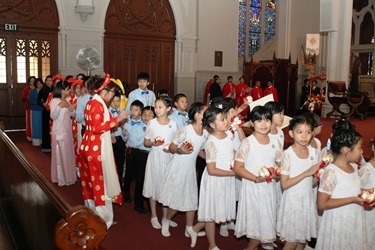
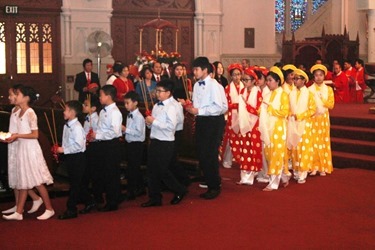
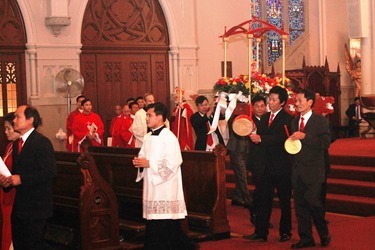
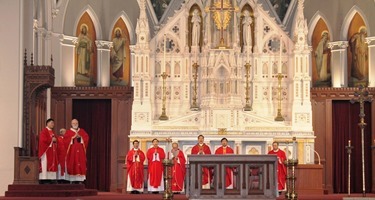
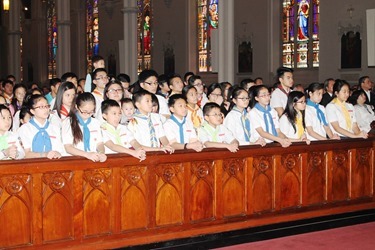 Father Linh Nguyen served as something of a master of ceremonies and, following the Mass, Mr. Tran from the Vietnamese Pastoral Council spoke.
Father Linh Nguyen served as something of a master of ceremonies and, following the Mass, Mr. Tran from the Vietnamese Pastoral Council spoke. 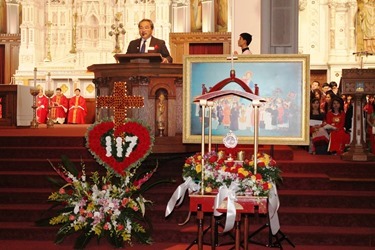
We are so grateful to Father Michael Harrington, and everyone at our Office for Cultural Diversity for all their hard work bring the Mass together.
I’d like to share my homily from the Mass with you here:
It is a great joy and a privilege for me to welcome all of you today, the Vietnamese Catholic community, to this your Cathedral of the Holy Cross. Your life of discipleship has been characterized by your fidelity to the cross. We all lament the tragic circumstances that led you to flee your native country, but we are filled with thanksgiving that God’s loving providence has brought you to our country, giving us such the faith filled brothers and sisters dedicated to the ideals that we all cherish and that form bonds stronger than blood. St. Augustine said: the bonds of the waters of baptism are stronger than the bonds of blood. When I became the Archbishop of Boston I thought I might learn some Vietnamese. But when I studied the elaborate tonal differences realizing that one syllable could have six different meanings depending on the pronunciation, allowing for an infinite number of possibilities to make a fool of oneself, I decided that the old English proverb is true. “You cannot teach an old dog new tricks.”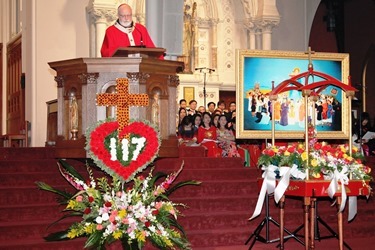
But today I speak to you with the language of Pentecost, the language of love which transcends all barriers, all languages, all races, all geography. As members of Jesus’s Church we are members of his family and brothers and sisters to each other regardless of whatever language we speak or whatever ethnic heritage we enjoy.
In 1975 with the fall of Saigon, Vietnamese immigration to America began and now we have the largest Vietnamese community outside of Vietnam. We know that many thousands perished in their attempt to flee Vietnam and find their way to the United States. Today, in this month of the holy souls, we lift them up in prayer. My own ancestors were boat people, many who perished in their attempts to come to this country.
Our own diocese has been so blessed with the presence of so many wonderful Vietnamese Catholics. Both of our seminaries, St. John’s and Pope John have had a number of Vietnamese seminarians preparing for the priesthood to serve in Vietnam or in Boston. Last summer, a group of the Vietnamese seminarians came to the Cathedral and prepared that wonderful Vietnamese lunch for me before returning home to Vietnam. They were trained here at St. John’s for their dioceses back home. We were so glad to have them here; their presence and witness enriched our seminary and made a lasting impression on our future priests.
Very fittingly, the word of God in today’s readings speaks to us about martyrdom. In the first reading from the Old Testament, the story of the sons of the Maccabees, describes for us how our spiritual ancestors endured torture and suffering rather than to renounce their faith in God. It was their faith in the resurrection from the dead that gave these brothers the courage to withstand the threats and torture of the evil King. They said boldly: “the king of the world will raise us up to live again forever.” It is the faith in the resurrection and in God’s loving mercy that also gave our martyrs the courage to embrace the Cross and lay down their life as a witness to their faith.
The second reading describes for us the martyrdom of St. Stephen, the Deacon. In the history of the Church, St. Stephen is called the proto-martyr, the first martyr. In so many ways Stephen’s death parallels Jesus’s death on the cross. Even Stephen’s last words are lifted from some of Jesus’s seven last words: “Lord Jesus, receive my spirit.” As Jesus had said: “Father, into thy hands I commend my spirit.” Stephen also asked God to forgive his executioners: “Lord, do not hold this sin against them.” As Jesus had said: “Father, forgive them, for they know not what they do.”
Tertullian said that the blood of the martyrs is the seed of the Church. This was certainly the case after the martyrdom of Stephen, where the Acts of the Apostles described for us how the Church expanded due to the persecution. However the most stunning conversion was that of Saul, the fanatic persecutor of the Church who participated in the martyrdom of St. Stephen. He later becomes St. Paul the apostle.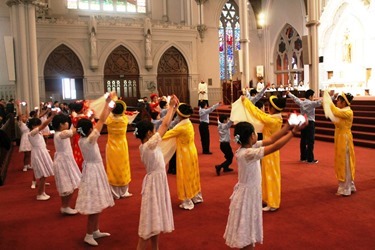
During the time of persecution of the early Church in Rome, the Christians hid in the catacombs where they celebrated Mass on the tombs of the martyrs. From that custom the practice of placing relics of the martyrs in our altars was established. Even today most of our altars have relics of the martyrs, so that even as we celebrate the Eucharist we are strengthened by the witness of their sacrifice.
Jesus in the gospel tells us: “if anyone wishes to come after me, he must deny himself and take up his cross. Whoever wishes to save his life will lose it, but whoever loses his life for my sake will save it.” The first generations of Christians were very inspired by these words of Jesus and saw in the martyrs the greatest ideal of our faith. In every century and throughout the world our brothers and sisters in the faith have lay down their life as a witness to their faith and fidelity to Jesus Christ. If ever you get to visit Rome, go to the catacombs, the place of the martyrs and visit also the church of San Bartolomeo. Pope St. John Paul II made that church into a sanctuary for the martyrs of the 20th century. In our modern times so many faithful disciples of Jesus are still shedding their blood for their faith.
Today we are anticipating the Feast of the Vietnamese Martyrs, canonized by St. Pope John Paul II in 1988. The Vatican estimates that there are between 130,000 and 300,000 martyrs in the history of the Church in Vietnam. Some of them date from the 17th century, including Dominicans, Jesuits and members of the Mission Etrangeres de Paris. One of those martyrs was Theophane Venard. His letters and example inspired the young St. Therese of Lisieux to volunteer to go to the convent of the Carmelites in Hanoi. The Saint died too young to fulfill that dream, but we see clearly how the Little Flower had the people of Vietnam in her heart.
In the 18th century there were also many martyrs in Vietnam. I read that those persecuting the Church commanded the Catholics to renounce their faith by walking over a wooden cross. It reminded me of the stories about the Japanese martyrs being commanded to walk on the fumi-es as depicted in the famous novel The Silence. It also reminded me of the stories of my own ancestors in Ireland when during the great famine, their persecutors offered them soup, telling them that they could eat if they would only renounce their Catholic faith. Countless Irish preferred to starve to death than to give up their faith. But also in modern times so many Vietnamese Catholics have suffered, even martyrdom rather than renounce their faith.
To me one of the most inspiring stories of modern martyrdom in Vietnam is the life of Cardinal François Xavier Nguyen Van Thuan whom I had the privilege to meet both here in Boston and in Rome. He spent 13 years in a reeducation camp, nine years in solitary confinement. In 2007 the beatification process for this great Vietnamese priest began. Pope Benedict the XVI referred to Cardinal Van Thuan as an example of holiness for Vietnamese Catholics and for the entire Church. He said “during 13 years in jail, in a situation of seemingly utter hopelessness, the fact that he could listen and speak to God became for him and increasing power of hope, which enabled him, after his release, to become for people all over the world a witness to hope, to that great hope which does not way even in the nights of solitude.” The martyrs are for all of us a sign of hope, hope in God’s loving mercy and in the resurrection. The very word martyr means witness. All of us are called to be witnesses to the resurrection. Our fidelity to the gospel and our desire to share the joy of the gospel with others will be a sign of hope to our contemporaries.
The world, more than teachers, needs witnesses. We must be those witnesses. That doesn’t mean necessarily that we will be called upon to shed our blood, but yes we will have to do difficult things, by the way that we love, and serve, and forgive. Our lives must be an invitation to others to follow the way of the Gospel. Pope Francis is challenging us to go out into the highways and byways and invite people to be part of Jesus’ family. The Holy Father tells us the Church is a field hospital. There are many wounded and sick who need to know that God loves and cares for them and has sent us to them to be messengers of His Gospel. A wonderful program for a life of missionary discipleship has been traced out for us by Cardinal Van Thuan in his 10 rules of life, which I keep in my breviary.
Let me conclude by sharing them with you:
— I will live the present moment to the fullest.
— I will discern between God and God’s works
— I will hold firmly to one secret: prayer.
— I will see in the holy Eucharist my only power.
— I will have only one wisdom: the science of the cross.
— I will remain faithful to my mission in the Church and for the Church as a witness of Jesus Christ.
— I will seek the peace the world cannot give.
— I will carry out a revolution by renewal in the Holy Spirit.
— I will speak one language and where one uniform: charity.
— I will have one very special love: the Blessed Virgin Mary.
– – –
Monday I went to Chicago to be present for the installation of the new archbishop there, Archbishop Blase Cupich.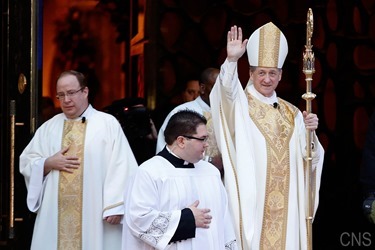
I can say that Chicago lived up to its reputation as the Windy City — and to top it off, it was freezing cold. But, despite the weather outside, was beautiful celebration inside the Holy Name Cathedral, which is also a Keeley church like our own Cathedral of the Holy Cross in Boston, and that has been beautifully renovated. 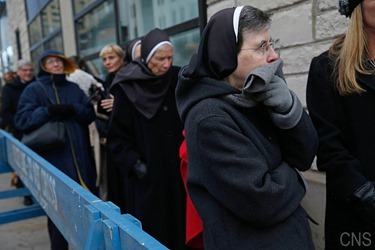
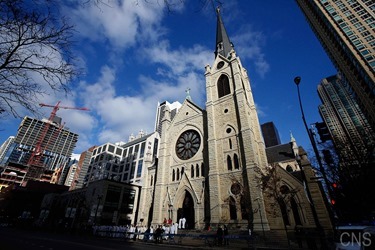
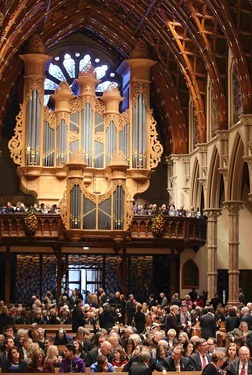
There was an enthusiastic welcome for the new archbishop, who was there with his nine brothers and sisters.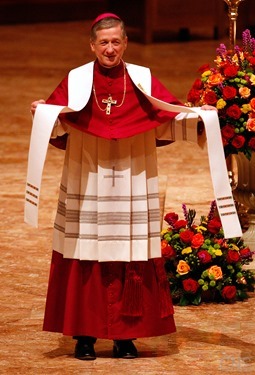
The liturgy had substantial portions in Spanish and in Polish. Chicago is one of the largest Polish-American communities in the U.S., and that was recognized in the Archbishop’s comments, the songs and the final blessing of the Archbishop gave in Polish.
Archbishop Cupich gave a beautiful reflection on the gospel, which was the reading of Jesus walking on the water.
Of course, in addition to being an occasion of welcome for the new archbishop, there was also a great outpouring of love and appreciation for Cardinal Francis George who is stepping down after 17 years as the Archbishop of Chicago. 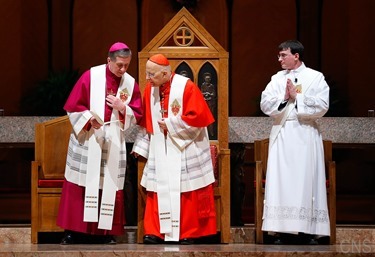
Cardinal George has served the Church in many different ways and in many different capacities, including serving as the president of the U.S. Conference of Catholic Bishops. He is a great intellectual light in our Catholic Church and a man whose voice is always respected.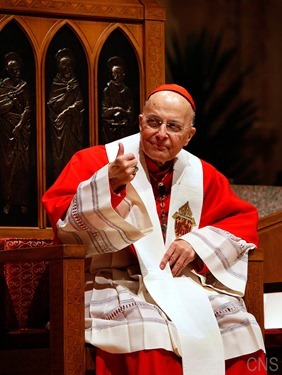
At the end of Mass, Archbishop Cupich publicly thanked Cardinal George and there was a thunderous standing ovation. Then Archbishop Cupich said, “Now you know not just how we think, but how we feel.”
That just elicited peals of laughter, because whenever Cardinal George was interviewed — and remember, Cardinal George is a very cerebral sort of fellow — the press would always ask: “Cardinal, how do you feel about that…”
And the Cardinal would always respond, “Don’t ask me how I feel, asked me how I think!”
– – –
Back in Boston on Wednesday, we had one of our periodic gatherings with those priests who have been ordained within the last five years. As is our usual practice, we had a Holy Hour followed by dinner and a conversation.
This time, we had a long discussion about some of the themes that had been brought up at the bishops’ meeting a week ago: Catholic schools, the pastoral letter on pornography that is being produced, and the Synod on the Family.
– – –
Finally, I’d like to invite all of you to join us at the Cathedral this Sunday, the Feast of Christ the King for Vespers Service at which we will present Cheverus Award Medals to 116 people who have done so much to serve our archdiocese.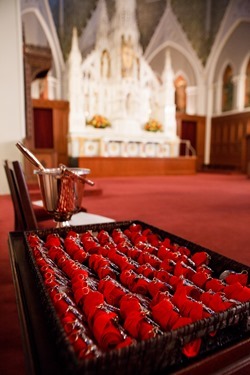
We initiated the Cheverus Medal in our bicentennial year to recognize those unsung heroes and heroines who are the engines that keep our parishes, agencies and services moving forward through their generous and faithful service. 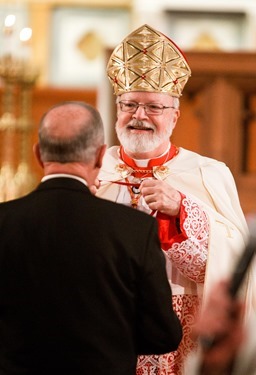
The service will begin at the Cathedral of the Holy Cross at 3 p.m. If you are unable to join us in person you can also watch the service live on CatholicTV through your cable service or at CatholicTV.com.
I look forward to seeing you all there!
Until next week,
Cardinal Seán
